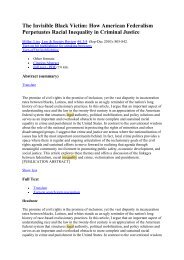Ski – resort and regional development: profile of visitors ... - E-Journal
Ski – resort and regional development: profile of visitors ... - E-Journal
Ski – resort and regional development: profile of visitors ... - E-Journal
Create successful ePaper yourself
Turn your PDF publications into a flip-book with our unique Google optimized e-Paper software.
48<br />
Filio Lazana, Diana Draganescu, Georgiana Grama, Magdalina Yarichkova<br />
this subject was the reception <strong>of</strong> 158 completed questionnaires, out <strong>of</strong> which 80 were completed<br />
manually <strong>and</strong> 78 electronically, registering an overall response rate <strong>of</strong> 45,14%. The survey<br />
instrument consisted <strong>of</strong> eleven closed-ended questions, out <strong>of</strong> which two general questions<br />
on travel habits, five demographic questions, targeting the outline <strong>of</strong> the respondents’ <strong>pr<strong>of</strong>ile</strong><br />
<strong>and</strong> four questions on the pattern <strong>of</strong> safety <strong>and</strong> security issues <strong>and</strong> on how perceptions <strong>of</strong> risk<br />
affect decisions to travel to certain destinations. The closed-ended questions were formulated<br />
so as to help the respondents in making quick decisions by choosing from several alternatives<br />
(Sekaran, 2001). The safety <strong>and</strong> security items were measured on a five-point Likert scale,<br />
labeled definitely disagree <strong>and</strong> definitely agree at the poles <strong>and</strong> neutral at the mid point, using<br />
a set <strong>of</strong> six items asking about their considerations regarding certain destinations recently<br />
affected by a crisis issue. The method according to which an answer was being considered<br />
valid was the ticking/checking <strong>of</strong> the one answer most appropriate to one’s perception. The<br />
written survey method was selected for this study to be more appropriate for the respondents<br />
to fill in the questionnaires at their own convenience.<br />
The sample surveyed represented respondents as it follows: 89% European, 7% American,<br />
2% Asian <strong>and</strong> 1% African. The differentiation by gender had it that 53% <strong>of</strong> the respondents<br />
were females, the majority <strong>of</strong> whom (49%) were between 26-44 years <strong>of</strong> age. A high percentage<br />
(43%) has an annual income level <strong>of</strong> less than f12.000 <strong>and</strong> 55% have a university or college<br />
degree. The majority (53%) <strong>of</strong> male respondents were between 26-44 years old, most <strong>of</strong> them<br />
(28%) having an annual income level <strong>of</strong> less than f12.000 <strong>and</strong> 54% had a university or<br />
college degree. Fifty-eight percent <strong>of</strong> the respondents traveled 1-3 times for leisure purposes<br />
in 2005 (table No. 1) <strong>and</strong> 49% traveled both within their country <strong>of</strong> origin <strong>and</strong> abroad (table<br />
No. 2).<br />
The information <strong>and</strong> data derived were analyzed <strong>and</strong> are discussed in this paper in order to<br />
provide more findings in an area which lacks research. The approach enabled some limited<br />
findings to be compared with secondary information, allowing thus the paper to illustrate the<br />
theory with realities.<br />
Table No 1: Travel for Leisure Purposes in 2005<br />
Tourism Today - Fall 2007 - Full Paper














